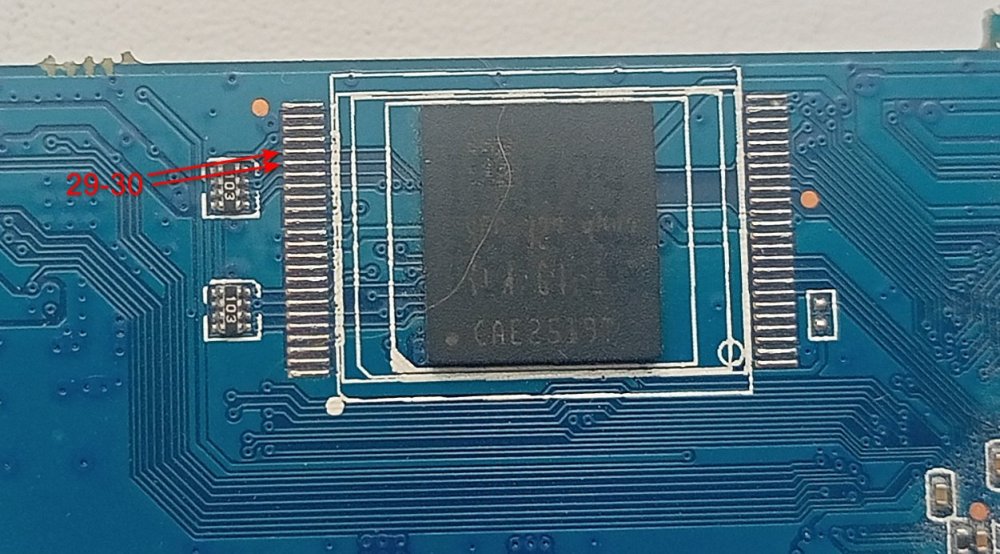All Activity
- Past hour
-
Thank you for the fast response. About wayland you are absolutely right that could be issue still i guess. I tried with the x version of the official driver not the wayland with XFCE, and as it has no ready wayland support i guess XFCE is out of question now. Can i ask you what desktop environment you recommend to try it with for better wayland support?
-

Wlan0 stopped showing up on Beelink GT1 Ultimate
moonlightzzz replied to moonlightzzz's topic in Amlogic CPU Boxes
No, I didn't change a thing. Things just break after upgrading. Today I did sudo apt-get update and apt-get full-upgrade after many months of not using the box, and broke agian. The kernel is now 6.12.32 and I can see that /boot/dtb/amlogic got updated to a June 4 date. sudo rfkill list shows nothing. -
Thank you - I should have checked w/ df. The reason is that /var/log is mapped to /dev/zram1 which is 47M for my system and auditd.conf requested space_left=75 (MiB, that is). I changed this to space_left=25% and admin_space_left=5%. No it starts to log something at least.
-
This needs to be enabled: https://github.com/armbian/os/pull/332 As we started with a model without HDMI port, this was simply overlooked. Build with: ./compile.sh ENABLE_EXTENSIONS="v4l2loopback-dkms,mesa-vpu" That I don't know how it works if at all. Wayland is troublesome even on 1st class x86 hardware. Update: will rebuild images later today with mesa extension enabled.
- Today
-
Hi all, I am new to kernel development, and I found an old ASUS tinkerboard. I want to give it a second life with some fun projects. The project I am building is another IP KVM, so I bought an HDMI to CSI module. After tinkering around for a while, I found I supplied the wrong clock for that module: [ 8.469299] tc358743 2-000f: unsupported refclk rate: 50000000 Hz [ 8.483069] kernel BUG at drivers/media/i2c/tc358743.c:593! I have no idea about the clock value to put in the dts file, so I just copied some values from the ASUS kernel source. From the driver code drivers/media/i2c/tc358743.c, it shows that there are only 3 valid clocks: switch (state->pdata.refclk_hz) { case 26000000: case 27000000: case 42000000: ... default: dev_err(dev, "unsupported refclk rate: %u Hz\n", state->pdata.refclk_hz); ... However, the clock values used in the dts file are some pre-defined macros: # dts configuration clocks = <&cru SCLK_VIP_OUT>; # include/dt-bindings/clock/rk3288-cru.h that contains the `SCLK_VIP_OUT` ... #define SCLK_CRYPTO 125 #define SCLK_MIPIDSI_24M 126 #define SCLK_VIP_OUT 127 ... I wonder if some folks have experience with the clock setting and can help me pick the correct value. Thank you.
-

Building Armbian Distribution with Kernel 6.10 for Orange Pi 5 Pro
SteeMan replied to Sergey Dulimov's topic in Rockchip
Technically a DTS is specific to a kernel version. As changes happen to the kernel apis, those need to be reflected in the DTS's. So they DTB and kernel image are always built and shipped together. Now in practice changes that impact the DTS aren't common, so you can usually use DTS's accross kernel versions. However in this case, I'm assuming that when you refer to 6.1 that is a vendor kernel, and 6.10 or greater would be mainline kernel. Now these are two very different code bases. A vendor kernel is whatever the board/cpu vendor hacked together to get a kernel running on their hardware. Often these are more android kernel based. When features finally get rolled into mainline, their implementation is often completely different. Thus one can't share a DTS between a vendor kernel and a mainline kernel. But often you can use the vendor DTS to gather information about what needs to be implemented in the mainline DTS. -
Hi @fabiobassa, Until recently, I thought that the TTY serial port and the SSH terminal were the same thing, just the different forms of communication! I learned how to use SSH here, it helped me a lot with remote access, which I didn't know about. A few days ago I was even trying to find out how the serial port works, even though I don't have the TTY USB adapter, I have Arduino boards here, Nano and Uno, could I use them as an adapter? Could you give a brief explanation of how it works? I'll try to do it, because just as SSH was very useful, I believe that this communication via the TTY port is more important for diagnostics! I'm grateful for the dedication of all of you who maintain this forum, thank you very much! P.S.: I'm using the oscilloscope, and I can't find the memory clock pin that enables markrom mode, and I didn't see a signal on the serial port!
-
damn, it looks like I screwed up the WiFi chip model Actually I have p9012s in my box. And if I understand correctly, there are no drivers for it and it won't work. I had a USB WiFi adapter on a Ralink MT7601U chip. It worked in this box right away. P.S. I still don't understand why I assumed that I have an esp8089 chip. Since I have two such TV boxes, I even disassembled the second one to check - but it also has a c9012p chip. A mystery to me) ___ By the way, the other day after an unsuccessful Armbian firmware update I almost got a brick. If earlier I was able to restore it using a PC and a USB-A - USB-A cable, this time the PC didn't even see this box. Maybe this will be useful to someone. I revived it by switching to mask mode by shorting contacts on emmc. launched RK Batch Tool 1.8 and specified the path to the stock firmware (don't forget about the drivers) completely disconnected the power supply to the box shorted contacts 29 and 30 to each other connected the box to the PC. The program immediately recognized it. All that was left was to flash it My box specifications: Rockchip RK3228A (Aida64 for some reason says that it is 3229), 2/16gb, WiFi S9012P. Board: MXQ_RK3229_V2.0 2019.07.2022
-
@KrzyPac You apply the patch to the kernel source-tree, In this case we will use meson64 as an example. Add the patch to: patch/kernel/archive/meson64-6.12/ Enable in the defconfig: echo "CONFIG_OPENVFD=m" >> config/kernel/linux-meson64-current.config Build a new IMG or KERNEL as one normally would for your unit. general-drv-auxdisplay-Add-openvfd-driver.patch
-
Hello, i am new here, an experienced back-end developer from Hungary, and my hobby is mostly doing some IOT stuff in my free-time. I'm big fun of the Armbian project a long time and checking its progress time to time cos its seems perfect for IOT usage and the NanoPi R3S was specially chosen by me for my ongoing project because of the Platinum support of the product as it seemed to be perfect fit with good enough video support to make IOT server with remote app for admin functions. Sadly as it seems the hardware acceleration is not supported i guess because there is no HDMI port on the product but with Panfrost + VirtualGL it could be a capable remote desktop solution and i have checked that on "BigTreeTech CB2" its already there so that could be added for that as well. For me it would be enough if i get some help to add that to the build script for only me for now! But maybe there are other people who could have good use of some kind of remote desktop solution for an app or a whole desktop. I almost got it working with the official driver but it is not possible sadly without forking VirtualGL to make it compatible with the gl4es faker, and also that limits to OpenGL 2.X apps only so with Panfrost (3.1) could much better and it won't need the faker either. Update: I have the non LTS version cos that's the only one i was able to buy but i just checked the LTS version which is the Platinum support for and it has HDMI so it could be useful even more.
-

Building Armbian Distribution with Kernel 6.10 for Orange Pi 5 Pro
salas replied to Sergey Dulimov's topic in Rockchip
@Efe ÇetinWhy DTB compiled for kernel 6.1 wont work in 6.10 kernel ? Should't that info about regulators, dt nodes , properties be the same? Second question: If I take DTS source for 6.1 and compile using dt compiler of 6.10, should it work ? -

Building Armbian Distribution with Kernel 6.10 for Orange Pi 5 Pro
salas replied to Sergey Dulimov's topic in Rockchip
@Sergey Dulimov Have you been able to make any progress ? -
spi1-cs0-pin and etc are defined in .dtsi file , since they are physical pins of the H616/H618 chip. But they are assigned to different pins of 26-PIN and 40-PIN of Zero3 and zero2w
-
This might be about PCI-E bifurcation not working or can also be something mixed up with other SERDES ports. ROCK3A just uses 1x PCIe3x2-lanes (for NVME) but the R5C 2x PCIe3x1-lanes. The second lane might not be enabled or the 1st 2.5GbE chip might get 2-lanes allocated. And/or any other mix-up, but less likely I think. If the USB3 ports work and also if you have a working M.2 E-key WiFi, it is likely that bifurcation not working. For my ROCK3A I have to use original Radxa U-Boot and Armbian vendor kernel 6.1.x, otherwise It doesn't do what I want. So you might use other U-Boot and other kernel. Or just the FriendlyElec OpenWrt based image, but that is not easy generic Debian Linux. For my R6C I got Armbian userspace/rootfs working with Armbian mainline based kernel was about 17 months ago. Also with Armbian vendor based kernel. I see in Armbian Bookworm with beta repo: # apt list | grep u-boot-nanopi-r5c linux-u-boot-nanopi-r5c-current/bookworm 25.8.0-trunk.244 arm64 linux-u-boot-nanopi-r5c-edge/bookworm 25.8.0-trunk.244 arm64 You can do similar grep for kernels. Install an alternative and see on which U-Boot it is based. Or maybe first pick an older image from archive. At least you must know what U-Boot and what kernel. For my ROCK3A i tried 3 U-Boot binaries and also 3 kernel flavor, so many combinations possible.
-

Tanix TX3 mini unable to boot from Memory card
tasknodes replied to tasknodes's topic in Amlogic CPU Boxes
i use ARMBIAN_20.10_Arm-64_buster_current_5.9.0 and i use ARMBIAN_20.10_Arm-64_focal_current_5.9.0 Maybe the dtb file Is not good ? -
I forgot to specify that I tried different combinations in the config. With any of these configurations in this tool after each restart the Wi-Fi module is not recognized. All the time is written - unknown
-
@Benedito Portela you are a long term user on this forum to don't know that debugging is a MUST !!!!!!! And you have such WONDERFULL uart pads, even with names ( tx rx gnd) ... why don't you use them and let all of us know what going in your box ??😇 😉
-
Hello @alg_42 You have only 1 GB of space in /tmp. This is tmpfs, so it uses your RAM. It is not enough to unpack your backup into. You can increase the size but the Pine64 either has only 512MB or 1GB of RAM, so that is not a good idea. I suggest you temporarily deactivate the /tmp mount instead, reboot, complete your backup and then reactivate the /tmp mount and reboot again. Armbian puts /tmp on tmpfs so that the frequent writes to it do not wear out your flash so it is important you reactivated it later on and don't leave it on your main partition indefinitely. Can you share the output of "grep tmp /etc/fstab" with us?
-
I'm, using one of those CH340 based usb-uart dongles https://www.aliexpress.com/w/wholesale-usb-uart-ch340.html but that normally most usb-uart dongles would work https://www.aliexpress.com/w/wholesale-usb-uart.html just make sure to check that it has / uses 3.3V io levels. Not 5V io levels as that may damage the processor (cpu / soc) for the pins connection review the user manual http://www.orangepi.org/html/hardWare/computerAndMicrocontrollers/service-and-support/Orange-Pi-Zero-3.html it is the 3 pins labelled Debug TTL UART on their board photo http://www.orangepi.org/img/zero3/0627-zero3 (6).png --- off-topic: for these small boards, I've basically stopped running them with an LCD monitor and keyboard as I find it a hassle as I'm using a desktop PC and trying to share the monitor. I mostly use them 'headless' using the usb-uart port. And in fact, after you setup the network appropriately e.g. set a static IP address or install avahi, the usb-uart console is no longer needed for static (fixed) IP address it is covered in the networking guide https://docs.armbian.com/User-Guide_Networking/ for avahi (MDNS) > apt install avahi-daemon avahi-utils edit /etc/avahi/avahi-daemon.conf [publish] publish-workstation=yes you can find the board on the ethernet over MDNS e.g. https://github.com/hrzlgnm/mdns-browser and you can ssh into the board over the network, e.g. using putty https://www.putty.org/
-
@RaptorSDS, it is a eMCP (kmqn10006m-b318), in others board, that use same type chip, working no problems, in this board, do not working nothing, it is lock, red led turn on! Before use the multitools, the board do not boot from my system in sdcard, it is not a good indicator and even so i did the burning image in board, It was stupid of me! I hope find the maskrom pin, it is a new board, do not believe that i lost it! Thank by attention!
-
Did a lspci and it only returns 1 NIC device on the pci bus...
-

We are ready to offer a Bountysource donation to Armbian
amazingfate replied to maximumsettings's topic in Orange Pi 5
There is no moonlight-qt packaged in this ppa for noble, you can build from source: https://salsa.debian.org/amazingfate/moonlight-qt -
Is there any trick to make use of the integrated fan on Radxa 25W PoE Hat? I'm using 4GB Radxa Rock 5C Lite Armbian_25.5.1_Rock-5c_bookworm_vendor_6.1.115_minimal Some guides mention that one should enable an overlay. I didn't find any relevant overlays in armbian-config. In the Radxa repo I found rock-5a-radxa-25w-poe.dts which specifies that it's also compatible with Rock 5C. I've compiled it and enabled it, but by default the fan is not spinning (on high temps) and I'm not sure how to investigate that. Also, does it matter that I have 5C Lite? As it has another chip: RK3582
- Yesterday
-

Tanix TX3 mini unable to boot from Memory card
SteeMan replied to tasknodes's topic in Amlogic CPU Boxes
What build of armbian are you using? Please provide the exact steps you are having problems with, your description of the problem is not clear. -
Connect to the orange pi's serial port with a usb-serial from your laptop. Make sure you connect the TX with the RX, and viceversa. The speed is 115200. You will see booting messages, before the login prompt. If nothing works, re-write the img to the microSD.








